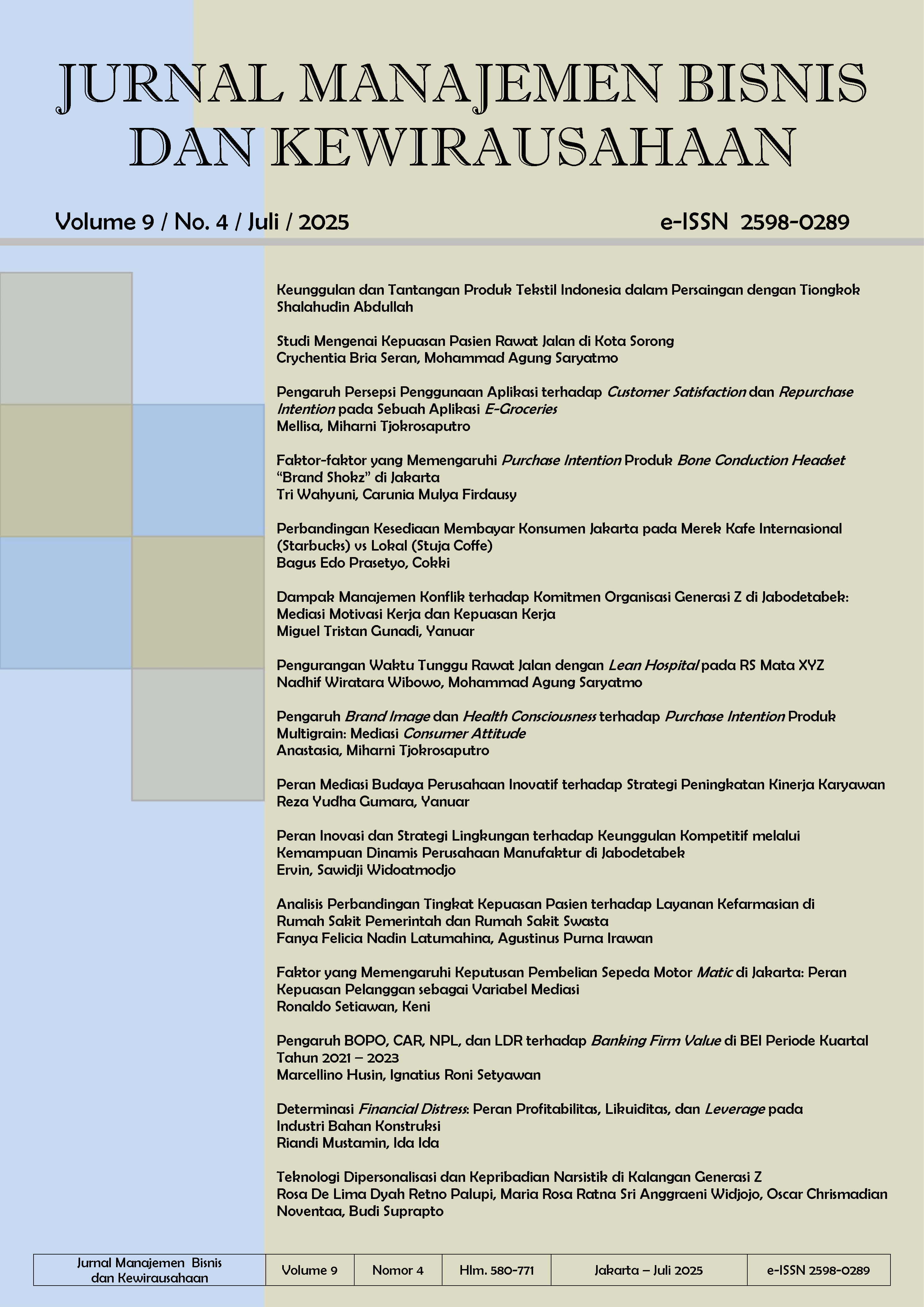Pengurangan waktu tunggu rawat jalan dengan lean hospital pada RS Mata XYZ
Main Article Content
Abstract
Long waiting times are one of the key indicators of inefficiency in outpatient services and can negatively impact patient satisfaction. This study aims to identify and reduce waste in the outpatient workflow of the ophthalmology clinic at XYZ Eye Hospital in 2025 using the Lean Hospital approach. This case study employed a Sequential Explanatory Mixed Method design, combining qualitative and quantitative approaches through direct observation, interviews, and secondary data analysis from the Electronic Medical Record (EMR) system. Value Stream Mapping (VSM) was used to map the process, with the Current VSM involving 2,673 patients. The analysis revealed that the most significant wastes occurred in doctor waiting time, registration, and the waiting period before assessment. Proposed solutions included locking the SEP printing feature at the KiosK 60 minutes prior to the scheduled appointment, deploying temporary staff to assist patients with the KiosK, and digitalizing the BPJS administrative process. In a simulated Future VSM involving 766 patients who arrived at least 60 minutes between their appointment time, there was a statistically significant reduction in lead time by 15.99% and in doctor waiting time by 26.87%. The study concludes that the implementation of Lean Hospital is effective in reducing waste and improving the efficiency of outpatient waiting times in a specialized eye hospital setting.
Waktu tunggu yang panjang merupakan salah satu indikator inefisiensi dalam pelayanan rawat jalan dan dapat berdampak pada kepuasan pasien. Penelitian ini bertujuan untuk mengidentifikasi dan mereduksi pemborosan pada alur pelayanan rawat jalan poli mata di RS Mata XYZ tahun 2025 dengan pendekatan Lean Hospital. Penelitian ini merupakan studi kasus yang menggunakan desain Sequential Explanatory Mixed Method dengan pendekatan campuran kualitatif dan kuantitatif melalui observasi langsung, wawancara, dan analisis data sekunder dari sistem Elektronik Rekam Medis (ERM). Value Stream Mapping (VSM) digunakan untuk memetakan proses, dengan Current VSM melibatkan 2673 pasien. Hasil analisis menunjukkan bahwa pemborosan terbanyak terjadi pada aktivitas menunggu dokter dan proses pendaftaran serta menunggu pengkajian. Usulan solusi meliputi penguncian cetak SEP di KiosK 60 menit sebelum janji temu, penambahan petugas sementara untuk memandu KiosK, serta digitalisasi proses administrasi BPJS. Hasilnya dengan Future VSM yang disimulasikan terhadap 766 pasien yang hadir minimal 60 menit di antara waktu janji, terdapat penurunan lead time secara bermakna sebesar 15,99% dan waktu tunggu dokter sebesar 26,87%. Penelitian ini menyimpulkan bahwa penerapan Lean Hospital secara efektif mampu mengurangi pemborosan dan meningkatkan efisiensi waktu tunggu dalam pelayanan rawat jalan rumah sakit khusus mata.
Article Details

This work is licensed under a Creative Commons Attribution-NonCommercial-ShareAlike 4.0 International License.
This work is licensed under a Jurnal Manajemen Bisnis dan Kewirausahaan Creative Commons Attribution-ShareAlike 4.0 International License.
References
Albalawi, M., Mahmud, A., Manaf, R. A., Nazan, A. I. N. M., Aljohani, A., & Mohamad, A. (2024). Improving the waiting time in outpatient clinics using lean approach in hospital: A systematic review. Malaysian Journal of Medicine and Health Sciences, 20(1), 263–270.
Astari, D. W., Sugiarti, T., & Rostieni, N. (2022). Analisis waktu tunggu pelayanan pasien di pusat mata nasional rumah sakit mata cicendo. The Journal of Hospital Accreditation, 4(02), 70–75.
Bustani, N. M., Rattu, A. J., & Saerang, J. S. (2015). Analisis lama waktu tunggu pelayanan pasien rawat jalan di balai kesehatan mata masyarakat propinsi sulawesi utara. EBiomedik, 3(3).
Duska, L. R., Mueller, J., Lothamer, H., Pelkofski, E. B., & Novicoff, W. M. (2015). Lean methodology improves efficiency in outpatient academic gynecologic oncology clinics. Gynecologic Oncology, 138(3), 707–711. https://doi.org/10.1016/j.ygyno.2015.07.001
Graban, M. (2016). Lean hospitals: Improving quality, patient safety, and employee engagement, third edition (Third edition). Taylor and Francis. https://doi.org/10.4324/9781315380827
Kam, A. W., Collins, S., Park, T., Mihail, M., Stanaway, F. F., Lewis, N. L., Polya, D., Fraser-Bell, S., Roberts, T. V., & Smith, J. E. H. (2021). Using lean six sigma techniques to improve efficiency in outpatient ophthalmology clinics. BMC Health Services Research, 21(1), 38. https://doi.org/10.1186/s12913-020-06034-3
Kemenkes. (2007). Keputusan menteri kesehatan republik indonesia nomor 1165/MENKES/SK/X/2007 tentang pola tarif rumah sakit badan layanan umum. Kemenkes.
Kemenkes. (2008). Peraturan menteri kesehatan nomor 129 tahun 2008 tentang standar pelayanan minimal rumah sakit. Kemenkes. https://www.regulasip.id/book/9233/read
Kemenkes. (2020). Peraturan menteri kesehatan nomor 3 tahun 2020 tentang klasifikasi dan perizinan rumah sakit. Kemenkes. https://peraturan.bpk.go.id/Details/152506/permenkes-no-3-tahun-2020
Kim, B., Wilson, S., Mosher, T., & Breland, J. (2021). Systematic decision-making for using technological strategies to implement evidence-based interventions: An illustrated case study. Frontiers in Psychiatry, 12, 640240. https://doi.org/10.3389/fpsyt.2021.640240
Lemmens, S. M. P., Lopes van Balen, V. A., Röselaers, Y. C. M., Scheepers, H. C. J., & Spaanderman, M. E. A. (2022). The risk matrix approach: A helpful tool weighing probability and impact when deciding on preventive and diagnostic interventions. BMC Health Services Research, 22(1), 218. https://doi.org/10.1186/s12913-022-07484-7
Njoto, L., Nasution, S. L. R., & Girsang, E. (2025). Implementation of the JKN program related to patient admission, medical data processing, reporting and JKN funding at murni teguh medan hospital. Eduvest-Journal of Universal Studies, 5(1), 513–530.
Nofriadi, N., Delima, M., & Sara, Y. (2019). Hubungan lama waktu tunggu pelayanan dengan kepuasan pasien poli penyakit dalam RSUD Painan. Prosiding Seminar Kesehatan Perintis, 2(1), 67–67.
Noviani, E. D. (2017). Penerapan lean manajemen pada pelayanan rawat jalan pasien BPJS rumah sakit hermina depok tahun 2017. Jurnal ARSI, 3(3), 219–230.
Pemerintah Pusat. (2023). Undang-undang (UU) nomor 17 tahun 2023 tentang kesehatan. Pemerintah Pusat. https://peraturan.bpk.go.id/details/258028/uu-no-17-tahun-2023
Pyzdek, T. (2021). The lean healthcare handbook: A complete guide to creating healthcare workplaces (2nd ed). Springer International Publishing AG.
Rizany, I., Setiawan, H., & Musafaah, M. (2021). The relationship between waiting time and patient satisfaction in the outpatient of public hospital in banjarbaru. IJNP (Indonesian Journal of Nursing Practices), 5(1), 60–66.
Rockville. (2017, October). Appendix B. Prioritize opportunities for improvement. Agency of Healthcare Research and Quality. https://www.ahrq.gov/patient-safety/settings/hospital/resource/pressureinjury/guide/apb.html?utm_source=chatgpt.com
Srinivasaragavan, D., Ramalingam, K., Ramani, P., & Dharini, S. (2024). Root cause analysis: Unraveling common laboratory challenges. Cureus, 16(2).
Woolard, I. (2018). High performance in hospital management: A guideline for developing and developed countries. SAMJ: South African Medical Journal, 108(7), 532–532.


